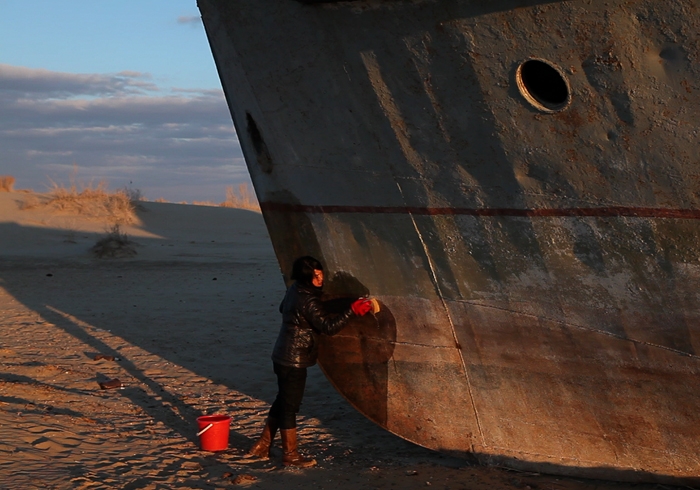The cover image of Patty Chang: The Wandering Lake, an artist book published as part of this exhibition at the Queens Museum, shows a mound dwelling that, amidst the ruins of the ancient Chinese city of Miran, resembles an upright breast and nipple. Miran, which was once an oasis stop along the Silk Road in northwest China, benefited from its proximity to the Lop Nor lake (the ‘wandering lake’ of Chang’s exhibition title) until the lake’s migration left the city isolated in the Taklamakan Desert. Chang’s foregrounding of this abandoned anthropomorphic structure illustrates her careerlong insistence on the body even when addressing issues like the rise and fall of dynasties, the unfixed landscape and the economics of water.
The Wandering Lake encompasses nine years in which Chang has travelled to, and worked in, sites including Xinjiang province in Western China; Newfoundland, Canada; the Aral Sea in Uzbekistan; and her father’s deathbed. It repeatedly touches on the relationship of the human body to various bodies of water. ‘It is interesting to look at geographic mapping as a way to contain history – how bodies of water shift and upend the intricate histories that are built up around them,’ Chang writes. ‘A geological body that shifts locations displaces and calls into question the systems and identities that rely on it.’
The exhibition is divided into three galleries, in which the project’s disparate parts – including several videoworks, vitrines containing archival research, photos adhered to plywood panels and blown glass urinary devices – intermix to varying effect, with the opening installation of two videoworks being the most striking. Titled Invocation for a Wandering Lake, Part I and Part II (both 2016), the juxtaposed projections succinctly evoke the themes running through the project. The two screens are composed of four sheets of cardboard joined at jagged angles, disrupting the projected images. The first screen is installed so that its left edge meets the left wall of the gallery, with the second just a few paces behind and running to the right wall, so that Part I peeks out from behind Part II. Each shows Chang steadily washing an oversized carcass in a place where economies tied to water have faltered.
The first video tracks Chang as she moves down and around the side of an abandoned, rusty ship in Muynak, Uzbekistan, where a once-thriving maritime community was destroyed by Soviet river-diversion projects that caused the Aral Sea to dry up. Chang moves along the hull with a bucket and sponge, wetting an area corresponding to her armspan in a gesture that feels simultaneously tender and futile. Towards the end of the video, Chang stops for breaks between wipes, and her exhaustion is evident: even while addressing the historical desertification of the site, she brings the viewer back to the exhaustion of her own body. In the next video, she uses an identical sponge to wash a dead whale on the shore of Fogo Island in Newfoundland, where the fishing community has been fractured by a federal moratorium on cod fishing. That this is a white sperm whale also calls to mind the history of commercial whaling in North America (Chang’s artist book quotes a passage from Moby-Dick, 1851).
The sound of the waves breaking against the body of the whale overlaps, because of the proximity of the works’ installation, with the slosh of the sponge against the ship’s side. As Chang works her way down the large white creature, she cautiously steps across the seafloor, never descending too far into the water where the whale’s lower body and broad forked tail undulate in the waves. The press release calls it a ‘ritual’ and ‘reparative’ washing, but it is unclear who the reparations are for – hunted whales, out-of-work fishermen or maybe even the artist’s father, who died two years prior. Chang allows her act to take on multiple metaphorical significances.
In these two key works, Chang attends to obsolete forms in order also to attend to the bodies, histories and cultures upended by disruption to water-related economies. They are in this sense representative of an exhibition in which she uses the movements, strains and tenderness of her own body to insist that we also consider the individual body when examining the past, present and future implications of the events that displace entire peoples.
Patty Chang: The Wandering Lake, 2009–2017 at Queens Museum, New York, 17 September – 4 March 2018
From the April 2018 issue of ArtReview
